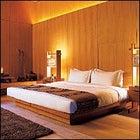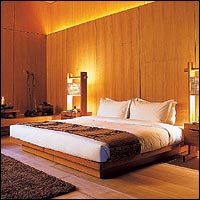Leave it to Bhutan—the Switzerland-size Buddhist kingdom wedged between Tibet and India that’s become the pinnacle of exclusive adventure travel—to be the new home of two ultra-indulgent lodges. Opening this month, Uma Paro, owned by Como Hotels and Resorts, is a 20-room, nine-villa mountain getaway set on 38 forested acres southeast of Paro, one of Bhutan’s main cultural centers and the site of its only airport. In contrast with the country’s basic family-run lodges and guesthouses, the modernist resort will offer Western extravagances like heated towel racks, DVD players, and minibars, not to mention a full spa, gym, sauna, indoor pool, and on-site restaurant serving gourmet Bhutanese cuisine. Special yoga weeks, tours of nearby museums and monasteries, and multi-day treks in the soaring Himalayas will be major draws. (Next up for Como: a series of luxury camps in the Paro Valley.)
Access and Resources
UMA PARODuring the fall festival season, doubles cost 0–0; villas, with butlers and private spas, 0–
,200. 011-975-232-6254,
AMANKORA
Doubles cost
,248, including all meals and some tours. Seven-day all-inclusive tours run ,614 for two. 800-477-9180,
For custom trips, contact Bhutan Travel, 800-950-9908,
Amankora Aman Resorts
 HIGH STYLE: sweet dreams at Amankora
HIGH STYLE: sweet dreams at Amankora
Just northwest of Paro is Amankora, owned by Amanresorts, which opened this past June in the foothills below a 17th-century Drugyel monastery, with access to trekking trails, whitewater rafting, and mountain biking. In the refined style of the company’s luxe hotels, such as Amandari in Bali, the resort’s 24 suites are outfitted with traditional bukhari woodstoves and terrazzo-clad baths. Amankora is the first of six lodges Amanresorts plans to build in Bhutan over the next two years, intending for guests to travel from one to the next on guided treks. Currently, Amankora offers seven-day tours of the country, including three nights at Amankora and four at partnering lodges in Thimphu and Punakha.
The new digs are consistent with Bhutan’s selective tourism philosophy: Restricted numbers of flights give entrée to fewer than 8,000 visitors a year, who must each spend a minimum of $200 a day in high season. “The Bhutanese have seen what happened in Nepal, how it turned into a sort of hippie tourism. That’s not the way they wanted to go,” says David Fardon, marketing communications director for Como Hotels and Resorts. Yak-dung facial, anyone?

